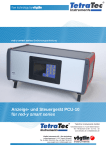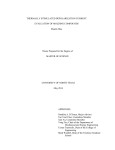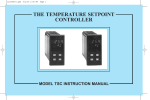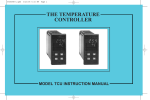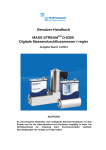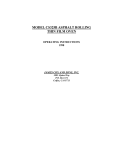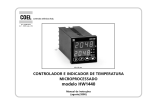Download FCRCGM-03 User Manual - Queen's
Transcript
FUEL CELL RESEARCH CENTRE Gas Blending System Model FCRCGM-03 User Manual QUEEN'S - RMC FUEL CELL RESEARCH CENTRE FCRCGM-03 945 Princess Street • 2nd Floor Kingston, ON K7L 3N6 Phone (613) 547-6700 • Fax (613) 547-8125 Table of Contents System Overview ....................................................................... 1 System Layout ................................................................................. 2 Front ......................................................................................................... 2 Top ........................................................................................................... 3 Back.......................................................................................................... 4 General ............................................................................................ 5 Plumbing .......................................................................................... 5 Plumbing Diagram .................................................................................... 5 Controls ........................................................................................... 6 Safety system .................................................................................. 6 System Installation ..................................................................... 6 Wiring ............................................................................................... 6 External flow control and monitoring ........................................................ 7 E-stop system expansion ......................................................................... 8 Gas Connections ............................................................................. 8 Safety considerations ...................................................................... 8 System Operation ...................................................................... 9 Gas Type Selection and Correction Factors .................................... 9 Mass Flow control ............................................................................ 9 Local set point control............................................................................... 9 External analog control ........................................................................... 10 Flow override .......................................................................................... 10 RS-232 computer control........................................................................ 10 Gas source and blending control ................................................... 10 Inlet gases .............................................................................................. 11 Metered gas streams – Straight out or mixed......................................... 11 Maintenance ............................................................................ 12 Troubleshooting ............................................................................. 12 Spare Parts .................................................................................... 14 System Specifications .............................................................. 16 Omega Process Controllers ..................................................... 18 Parameter Settings ........................................................................ 18 Parameter ........................................................................................ 18 Setting............................................................................................. 18 OEM Documentation ................................................................ 20 Document Listing ........................................................................... 20 Document ....................................................................................... 20 Website ........................................................................................... 20 Notes: ....................................................................................... 21 F C R C G M - 0 3 U S E R M A N U A L System Overview Four channel gas control and blending. T he FCRCGM-03 is a four channel gas delivery and blending system. This manual details the use, capabilities, specifications and care of the system. I C O N K E Y 1 Valuable information G Safety Information 1 F C R C G M - 0 3 U S E R M A N U A L System Layout Front Item 1 2 3 4 5 6 7 8 9 10 11 12 13 Function Common Inlet MFC 1 Inlet MFC 2 Inlet MFC 3 Inlet MFC 4 Inlet MFC 1 RS-232 data connection MFC 2 RS-232 data connection MFC 3 RS-232 data connection MFC 4 RS-232 data connection E-stop button E-stop reset button and status indicator Temperature limit switch override Temperature limit switch 2 F C R C G M - 0 3 U S E R M A N U A L Top Item 1 2 3 4 5 6 7 8 9 10 11 12 13 14 15 16 Function MFC 1 Inlet selection ball valve MFC 1 Outlet selection ball valve MFC 2 Inlet selection ball valve MFC 2 Outlet selection ball valve MFC 3 Inlet selection ball valve MFC 3 Outlet selection ball valve MFC 4 Inlet selection ball valve MFC 4 Outlet selection ball valve MFC 1 Omega process controller MFC 2 Omega process controller MFC 3 Omega process controller MFC 4 Omega process controller MFC 1 Flow override switch and indicators MFC 2 Flow override switch and indicators MFC 3 Flow override switch and indicators MFC 4 Flow override switch and indicators 3 F C R C G M - 0 3 U S E R M A N U A L Back Item 1 2 3 4 5 6 7 8 9 10 11 12 13 14 15 16 Function AC power connector Thermocouple input for over-temp shutoff Power switch Cabinet ventilation inlet E-stop extension connector Analog signal connector MFC 1 control switch MFC 2 control switch MFC 3 control switch MFC 4 control switch Mixed gas outlet MFC 4 gas outlet MFC 3 gas outlet MFC 2 gas outlet MFC 1 gas outlet Cabinet ventilation outlet 4 F C R C G M - 0 3 U S E R M A N U A L General The FCRCGM-03 gas delivery and blending system can be used as a stand-alone unit, or connected to a computer or analog controller for external control. An integrated E-stop circuit allows analog set point control only when applicable safety criteria are met. Plumbing Gas flow through the system is controlled by four Mass Flow Controllers, herein referred to as MFC1, MFC2, MFC3 and MFC4. Refer to the System Specifications section of this manual for the specifications of each MFC. There are five inlet gas connections at the front of the machine. The first gas input line connects to a manifold available to each of the four mass flow controllers in the system. This port is referred to as the Common inlet. The remaining four gas inlet connections correspond their relative mass flow controllers. The inlet gas to each MFC is selected from either the common manifold or the inlet connection specific to the MFC. The outlets of the MFC’s are in a similar configuration to the inlets. Five outlet ports are located at the back of the system; one outlet for each MFC, and one outlet common to all MFC’s used for gas blending. This configuration is meant to provide versatility in that the each MFC can provide gas blending capability or simply be used to control a single gas flow. Plumbing Diagram 5 F C R C G M - 0 3 U S E R M A N U A L Controls The MFC’s in the system can be controlled by four methods; manually specifying a set point via the Omega process controllers (local control), an external analog 4-20mA signal, a flow override switch forcing zero or full flow, or RS-232 control using a PC and Bronhorst Flow View or Flow Plot. Read back of the MFC process value in all modes of control is available in the top section of the Omega process controllers. The MFC process values can also be connected to external devices for data logging etc. Safety system An expandable hard-wired safety system is included with the FCRCGM-03. The safety system monitors e-stop trigger devices and halts flow through the MFC’s if a problem is detected. There are two on-board e-stop triggers; an e-stop button, and a Watlow temperature switch (used with an external K type thermocouple. The temperature switch can also be bypassed if this control is not applicable to the application. Additional e-stop devices may be added to the e-stop loop, and a relay e-stop status output is available to external devices. The system must be out of e-stop in order to flow gases in either local or external analog control. To get the system out of e-stop; - Ensure all external e-stop devices are in a closed-switch state - If no external e-stop devices are present, ensure the external e-stop jumper is installed - If an external thermocouple is connected, ensure the temperature limit override switch is up (not bypassed) and press the Reset button on the Watlow temperature switch - If no external thermocouple is used, set the temperature limit override switch to the down position to bypass the circuit - Ensure the red e-stop button is pulled out - Press the green e-stop reset button. The button should illuminate indicating the system is out of e-stop and ready to control gas flow G Note: The e-stop circuit is bypassed for MFC’s under RS-232 control. System Installation Wiring Electrical connections to the system are used for e-stop expansion, external gas control and monitoring, and MFC calibration. 6 1 2 3F C R 4C G M5 - 0 36 7 8 M A9N U10 11 A L U S E R 12 13 14 External flow control and monitoring To externally control and monitor gas flow with analog signals, use the 14 pin phoenix connector at the back of the system. External set points to the MFC’s are sent via 4-20mA signals corresponding to 0 to full scale flow of the MFC. Note that these connections DO NOT share a common ground reference. The process value (actual flow achieved) through each MFC is available at the phoenix connector as 0-10 VDC signals representing zero to full flow. The process value signals do share a common ground reference. Cables connected to the 0-10 VDC signals should be shielded with an earth ground connection to the shield at only one end of the cable. The shielding of these cables will reduce the effect of outside electrical noise on the signals to external monitoring equipment. Cable length should be as short as possible to reduce voltage loss due to cable resistance. Terminal number 1 2 3 4 5 6 7 8 9 10 11 12 13 14 Connection MFC 1 negative set point signal (4-20 mA) MFC 1 positive set point signal (4-20 mA) MFC 2 negative set point signal (4-20 mA) MFC 2 positive set point signal (4-20 mA) MFC 3 negative set point signal (4-20 mA) MFC 3 positive set point signal (4-20 mA) MFC 4 negative set point signal (4-20 mA) MFC 4 positive set point signal (4-20 mA) MFC 1 process value (0-10 VDC) MFC 2 process value (0-10 VDC) Common (for process values) Common (for process values) MFC 3 process value (0-10 VDC) MFC 4 process value (0-10 VDC) 7 F C R C G M - 0 3 U S E R M A N U A L E-stop system expansion The four pin connector at the back of the system is used for e-stop expansion. Pins 1 and 2 of the connector are an extension of the e-stop device loop. These pins should be jumpered when no additional e-stop devices are connected. Any additional e-stop devices to be added to the loop must be switched output devices with the output contacts closed when the measured levels of the device are within operating limits. Pins 3 and 4 are connected to a safety relay contact. The contact is open when the system is in an estop condition, and closed when the safety system is out of e-stop and reset. This contact can be used as a switch for external devices such as solenoids, lights, alarms etc. This relay output is rated: Output Rating AC: Output Rating DC: Inductive AC, 3 A/230 VAC Inductive DC, 2 A/24 V Gas Connections Gas connections to the system are shown in the system overview layout pictures (front and back). Use Swagelok ¼” connectors for all tubing in and out of the system. Take care not to over tighten these connections, as it will reduce the number of times the tube connectors can be used without leakage. The MFC’s have been calibrated with an input pressure of 5 bar. If a higher input pressure is required, the MFC(s) should be re-calibrated to the applicable pressure. Safety considerations Operators of this system must fully read and understand this manual. An integrated E-stop system included with the FCRCGM-03. Tied into this e-stop system is a Watlow LV temperature limit controller. This controller should be enabled when gases controlled through the system are fed to external setups that have the possibility of over temperature conditions requiring fuel flow shutoff. Similarly, the external e-stop loop connection should be connected if there are any setup specific conditions possible that would require gas flow shutoff. G The RS-232 connections to the MFC’s bypass the E-stop circuitry. For applications requiring the estop system to be enabled, analog control (either local or remote) must be used. G Gases connected to the FCRCGM-03 such as fuels and Oxygen should have a flame arrestor installed at the cylinder. G MFC 3 and it’s associated components have been cleaned for Oxygen service. Do not flow hydrocarbons through MFC 3. Doing so could damage the sensor element in the MFC. Check all gas connections for leaks prior to running the system. 8 F C R C G M - 0 3 U S E R M A N U A L System Operation Gas Type Selection and Correction Factors Four DB9 connectors are available at the front panel of the system for communication to Bronkhorst EL-Flow MFC’s. The EL-Flow series of MFC’s is capable of storing up to eight calibration curves for various gases. Four software programs from Bronkhorst are used to communicate to the MFC’s: FlowDDE: Software tool to establish communications between Windows and an MFC FlowDDE 2nd: Software tool to establish communications between Windows and an MFC FlowPlot: Software for monitoring and optimizing digital instruments parameters FlowView: Software to operate Bronkhorst digital instruments and select gas calibration curves Connect the appropriate DB9 on the instrument to an x86 Windows based computer using a standard RS-232 extension cable. To select the active calibration curve: - Establish communications using FlowDDE (or FlowDDE 2nd if FlowDDE is already communicating with another MFC) - Select the active curve with FlowView. If the desired gas type calibration curve is not listed in flow view, the curve can be added or a gas conversion factor can be applied to estimate actual flow. Further details about calibration and installing additional gas curves are contained the Maintenance section of this manual. A list of the pre-installed calibration curves for each MFC can be found in the System Specifications section of this manual. 1 G Mass Flow control Note: The system must be out of E-stop to enable set point signals to be sent to the MFC’s in Manual set point control, External analog control, and Flow override modes. MFCs should never be commanded a set point when source gas is not available or a gas exit path is blocked. These conditions can cause the MFC valve to over heat and lose calibration due to the fact the valve tries to keep opening to get the actual gas flow to meet the set point. To avoid this scenario, always set the flow override switches to the down position (red LEDs lit), and move the switches of only active MFCs to the middle position (orange LEDs lit) when you are ready to flow gas. Local set point control To use this function, set the corresponding control switch at the back of the unit to the down position. The Omega process controller will display “MN” indicating that the unit is set for local manual control. Press the up or down arrows on the process controller to adjust the set point. 9 F C R C G M - 0 3 U S E R M A N U A L Finally, set the flow override switch to the middle position. The orange LED will illuminate indicating that the MFC is set for set point control. External analog control To use this control type, set the MFC control switch to the up position. The Omega process controller should NOT show “MN”. The flow override switch must also be in the middle position with the orange LED lit. The MFC can now be controlled via a 4-20 mA signal connected to the analog signal connector at the back of the system. See the System Installation – Wiring section of this manual for details on external analog signal connections. Flow override Flow override of no flow, or full scale flow is set with the flow override switch to the right of each process controller. This is a three-position switch that will stop gas flow (red LED lit), allow set point control (orange LED lit), or send a full flow command to the MFC (green LED lit). RS-232 computer control Computer control using Bronkhorst software is achieved by connecting a PC serial port to the MFC RS-232 connectors located at the front of the machine. Four software programs from Bronkhorst are used to communicate to the MFC’s: FlowDDE: Software tool to establish communications between Windows and an MFC FlowDDE 2nd: Software tool to establish communications between Windows and an MFC FlowPlot: Software for monitoring and optimizing digital instruments parameters FlowView: Software to operate Bronkhorst digital instruments and select gas calibration curves Connect the appropriate DB9 on the instrument to an x86 Windows based computer using a standard RS-232 extension cable. FlowDDE and/or FlowDDE 2nd must be started to establish communications with the MFC(s). FlowView or FlowPlot can then be used to control the MFC’s. 1 Note: Currently the RS-232 connections only support two MFCs at one time from a single computer. Run FlowDDE and FlowDDE 2nd with one instance for each MFC to communicate with two instruments. Bronkhorst may release additional DDE’s to support more simultaneous connections in the future. Check www.bronckhorst.com for updates. If more than two MFCs must be controlled via RS-232, it is possible to use two computers, or upgrade the MFC hardware to include a FlowBus communications card. 1 Note: The MFC Control type is set using FlowView. Setting this parameter to RS-232 will disable analog control through the Omega process controllers. This also bypasses the e-stop circuitry. Gas source and blending control Ball valves on the top panel are used to direct inlet and outlet gas streams. 10 F C R C G M - 0 3 U S E R M A N U A L Inlet gases Each of the four MFC’s in the system is connected to a dedicated gas inlet port and a common inlet manifold. This selection between the two inlet sources for each MFC is done via the four ball valves on the left side of the top system panel. If the valve handle is pointing down, the MFC inlet is connected to the common manifold. If the valve handle is pointing up, the MFC inlet is connected it’s own inlet port. Metered gas streams – Straight out or mixed The four ball valves in the centre of the top panel are used to specify the outlet direction for each MFC, either to the mixed gas manifold, or straight out of the system. If the valve handle is pointing down, the MFC outlet is connected to the common mixed gas manifold. If the valve handle is pointing up, the MFC inlet is connected it’s own outlet port. Check valves from each MFC to the mixed line prevent backflow from the mixed gas manifold. 11 F C R C G M - 0 3 U S E R M A N U A L Maintenance With normal use, no routine maintenance is required. For applications requiring precise flow control, gas flows can be verified using a Molbloc (or similar) flow meter. MFC gas lines may be flushed with clean, dry inert gas. Troubleshooting Symptom Possible Cause No flow when commanded Unit in e-stop (local set point on Omega process controller(s) Resolution - No gas supply to MFC - Flow override switch is in the wrong position - Excessive pressure - back MFC Control Switch is in the wrong position - Blown MFC fuse - 12 Check e-stop devices Pull e-stop button out Ensure over temp limit switch override is engaged if a thermocouple is not connected. Reset over-temp limit switch if a thermocouple is connected Ensure e-stop expansion connector is jumpered if no external e-stop devices are connected. Press green reset button Ensure gas is connected with a pressure of 35 PSIG Check that the gas is connected to the proper inlet port Check the inlet ball valve is connecting the MFC to the correct inlet port Move the flow override switch to the middle position (orange LED will light) Ensure the outlet ball valve is in the correct position to direct flow to the desired outlet port. Check external gas connections for blockage Set the MFC control switch to the down position (“MN” will display on MFC) Replace fuse (400 mA fuse) F C R C G M - 0 3 U S E R M A N U A L 24 VDC power supply failure - Check 24 VDC power supply fuse. No power electronics to - Omega process controller(s) Blown controller not powered fuse(s) - Plug unit into 115 VAC Check main power fuse (integrated into power socket on rear panel Replace fuse(s) Flow override will not force 10V signal not full flow through MFC reaching MFC - Check 10V regulator board for proper output - See “No flow when commanded” symptom in this troubleshooting guide Check set point wiring connections on Pheonix connector at rear panel Ensure hardware used to send set point is functioning properly Check e-stop devices Pull e-stop button out Ensure over temp limit switch override is engaged if a thermocouple is not connected. Reset over-temp limit switch if a thermocouple is connected Ensure e-stop expansion connector is jumpered if no external e-stop devices are connected. Press green reset button Ensure gas is connected with a pressure of 35 PSIG Check that the gas is connected to the proper inlet port Check the inlet ball valve is connecting the MFC to the correct inlet port Move the flow override switch to the middle position (orange LED will light) System will not turn on Other No flow when commanded Set point not (external 4-20 mA set point) received by MFC Unit in e-stop - No gas supply to MFC - Flow override switch is in the wrong position - Excessive pressure - back - 13 Ensure the outlet ball valve is in the correct position to direct flow to the desired outlet port. Check external gas connections for blockage F C R C G M - 0 3 U S E R M A N U A L Flows not at expected values MFC Control Switch is in the wrong position - Set the MFC control switch to the up position (“MN” will NOT display on MFC) Blown MFC fuse - Replace fuse (400 mA fuse). 24 VDC power supply failure - Check 24 VDC power supply fuse. Incorrect calibration curve loaded on MFC - Inlet to outlet pressure difference to small - Connect to MFC via FlowView and select the proper calibration curve. Note: if the desired calibration curve is not available in the MFC memory, additional curves can be added (up to eight on each MFC). A correction factor can also be applied to estimate actual flow. A delta P of ??? from inlet to outlet is required for the MFC to operate properly. Check for sufficient inlet pressure Check for excessive backpressure Calibrate MFC MFC requires calibration Spare Parts Description Supplier - Part Number MFC fuses ( Fast 400mA Short Digi-Key UL TE5) Omega controller fuses (5x20mm GY 250mA) 24 V power supply fuse (5x20mm GY 2A) STi SR-103 safety relay fuse (5x20mm GY 150mA Watlow LV series fuse (5x20mm GY 200mA) 1/3 PSI Check valve Swagelok Digi-Key # WK4340BK-ND Manufacturer # 39504000440 SS-4C-1/3 Note: The #3 gas line is cleaned for O2 service. The part number for the check valve in this line is SS-4C-1/3-SC11 14 F C R C G M - 0 3 U S E R M A N U A L 15 F C R C G M - 0 3 U S E R M A N U A L System Specifications Electrical Voltage 110 – 120 VAC 60Hz Operating Current Draw (Max) Approx 3.6A Operating Environment Temperature Humidity Storage temperature 0 to 70 deg C 0 to 90% RH, non-condensing -40 to 85 deg C Plumbing Tubing material Tubing Size Check valves 316 Stainless Steel ¼” O.D, 0.035” wall thickness 1/3 PSI cracking pressure Ball valves 0.35 Cv MFC’s General Manufacturer Model Input pressure Maximum Accuracy Warm-up time Plumbing connections Material (wetted parts) Seals Communication Inrush could exceed max Seal material: Fluorocarbon FKM Bronkhorst EL-Flow 100 bar Calibrated to 5 bar ±1% FS for ranges > 3ml/min ±2% FS for ranges < 3ml/min 30 min. for optimum accuracy 2 min. for ±2% FS ¼” Swagelok compression Stainless steel 316L Viton RS-232, Analog 0-10VDC Note: Omega process controllers that send external set point to MFCs require 4-20 mA signal in. MFC 1 Gas cal. curves pre-loaded Flow Range 500 mls/min 500 mls/min 500 mls/min 500 mls/min H2, CO2 CO N2 16 F C R C G M - 0 3 U S E R M A N U A L MFC 2 Gas cal. curves pre-loaded H2, CO2 CO N2 Flow Range 250 mls/min 250 mls/min 250 mls/min 250 mls/min O2 CO2 CO Flow Range 100 mls/min 100 mls/min 100 mls/min H2, CH4 C2H6 C3H8 C3H6 C2H4` Flow Range 50 mls/min 50 mls/min 50 mls/min 45 mls/min 50 mls/min 50 mls/min MFC 3 Gas cal. curves pre-loaded MFC 4 Gas cal. curves pre-loaded Process Controllers Manufacturer Model Omega CN63300-R1-R2-F3-RSP 17 F C R C G M - 0 3 U S E R M A N U A L Omega Process Controllers Parameter Settings Mnemonic Parameter CN63300 Configure Input 1-INP tYPE Input Type dCPt Decimal Point rnd Rounding Element FLtr Digital Filtering dSP1 Display Value #1 InP1 Signal Input Value #1 dSP2 Display Value #2 InP2 SPLO SPHI Setting Volt 0.0 0.1 1 0 0 MFC 1: 500 MFC 2: 250 MFC 3: 100 MFC 4: 50 10 0 MFC 1: 500 MFC 2: 250 MFC 3: 100 MFC 4: 50 0 RSP Signal Input Value 2 Setpoint Lower Limit Setpoint Upper Limit SPrP Setpoint Ramp Rate InPt User Input CN63300 Configure Output 1-OP CYCt Cycle Time OPAC Output Control Action OPLO Output Lower Limit OPHI Output Upper Limit OPdP Output Power Dampening CHYS ON/OFF Control Hysteresis tcod Auto-Tune Dampening Code ANtP Linear Output Range ANAS Linear Output Source ANUt Linear Output Update Time ANLO Linear Output Scale Point Low ANHI Linear Output Scale point High 0 REV 0 100 1 0.1 0 0-10 SP 0 0 MFC 1: 500 MFC 2: 250 MFC 3: 100 MFC 4: 50 18 F C R C G M - 0 3 U S E R M A N U A L Configure Lockouts 3-LC SP Access Setpoint OP Access Output Power dEv Access Deviation Display UdSP Access Display Units Code Access Code Number PId Access PID Values AL Access Alarm(s) Values ALrS Enable Reset Alarm(s) SPSL Enable Remote/Local Transfer trnF Enable Auto/Man Transfer tUNE Enable Auto-tune Configure Alarms 4-AL Act1 Alarm 1 Action Mode rSt1 Alarm 1 Reset Mode Stb1 Alarm 1 Standby Enabled AL-1 Alarm 1 Value Act2 rSt2 Stb2 AL-2 Ent LOC RED RED 2 LOC LOC LOC LOC LOC LOC Alarm 2 Action Mode Alarm 2 Reset Mode Alarm 2 Standby Enabled Alarm 2 Value AHYS Alarm Hysteresis Value Configure Remote Setpoint 7-rS / 7-n2 dSP1 Remote Setpoint Display Value #1 INP1 Remote Setpoint Input Value #1 dSP2 Remote Setpoint Display Value #2 INP2 FLtr bAnd trnF Remote Setpoint Input Value #2 Remote Setpoint Filter Time Constant Remote Setpoint Filter Band Local/Remote Transfer Options 19 b-ot Auto yes MFC 1: 50 MFC 2: 25 MFC 3: 10 MFC 4: 5 b-ot Auto yes MFC 1: 550 MFC 2: 225 MFC 3: 110 MFC 4: 55 0.1 0 4 MFC 1: 500 MFC 2: 250 MFC 3: 100 MFC 4: 50 20 1 0.5 NOR OEM Documentation For further information on the components within the FCRCGM-03, consult the following documents and websites: Document Listing Component(s) Document Bronkhorst MFCs Bronkhorst Doc. No. 9.17.022O Omega process CN63100/63300 Series 1/16 DIN controllers Temperature/Process Controllers User’s Guide Watlow Watlow Doc. No. 0600-0044-0001 Rev. G Series L User’s Manual Sti SR103AM SR103AM Spec sheet Safety Relay 24VDC Power Type SPD 60W power supply spec sheet supply Swagelok components 20 Website www.bronkhorst.com www.omega.com www.watlow.com www.sti.com www.gavazzionline.com www.swagelok.com Notes: Keep operating and maintenance notes here 21 . 22

























